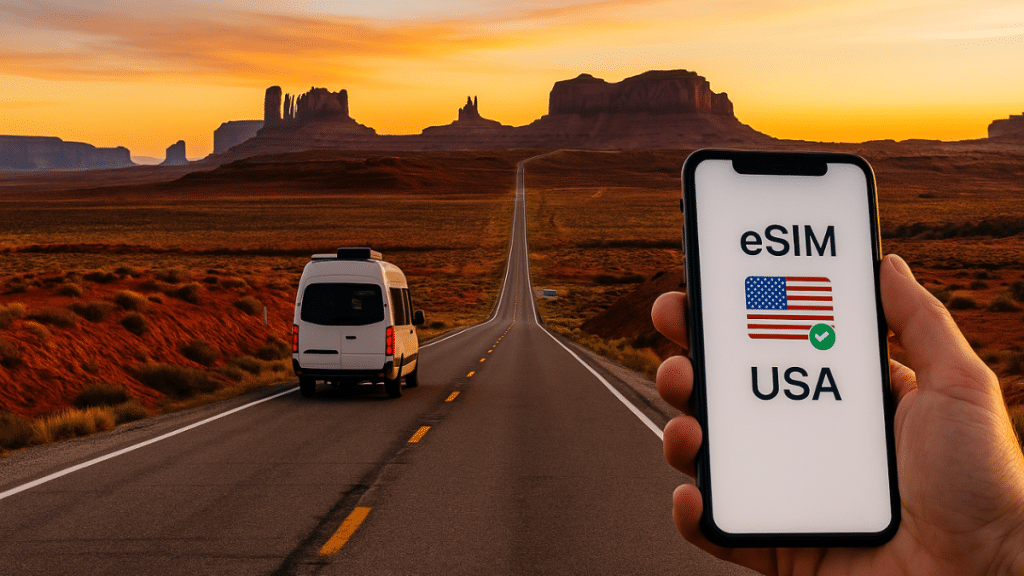Why an eSIM Beats a Drawer of Plastic SIMs
Digital nomads love the phrase “work from anywhere”—right up until the moment they cross a state line and their phone stubbornly clings to 3G. An eSIM (embedded Subscriber Identity Module) rewrites that story. Instead of swapping physical cards at every carrier store, you download a mobile-network profile straight onto the chip already soldered inside modern phones, tablets and some laptops. No tiny trays, no poking with a paperclip, no risk of losing your home-number SIM in a cup-holder full of coins.
For this tech field test my partner and I drove 3,921 miles from Miami’s mangroves to Washington’s Olympic peaks, working from the back of a self-converted Sprinter. Our connectivity lifeline? A single QR code—Holafly’s eSIM USA—installed on two iPhones and an M2 iPad Pro.
The Route at a Glance
| Week | Region | Anchor Stop | Primary Work Tasks | Network Observations |
| 1 | Southeast | New Orleans, LA | Client Zoom calls, Shopify updates | 5G Ultra-Wideband in city; 4G along the bayous |
| 2 | Southwest | Sedona, AZ | Video edits, Lightroom exports | 5G mid-band in Flagstaff; solid 4G on I-40 |
| 3 | Pacific Coast | Big Sur, CA | Webinar hosting, SaaS support shift | Streamed 1080p flawlessly via 4G LTE |
| 4 | Pacific NW | Olympic NP, WA | Git commits, analytics dash | 5G in Port Angeles; 2-3 bars 4G at remote trailhead |
Tech Setup Inside the Van
Hardware
- iPhone 15 Pro Max (dual eSIM)
- Pixel 8 Pro (physical SIM + eSIM)
- iPad Pro 13″ cellular
- M1 MacBook Air tethered via hotspot
- WeBoost Drive Reach RV antenna for marginal zones
Software
- Speedtest by Ookla for benchmarking
- Slack, Zoom, Figma, VS Code over Tailscale VPN
- Gaia GPS & Apple Maps offline layers for dead spots
How the eSIM Held Up in Real-World Use
- Instant activation: Scanned the QR in Miami Starbucks; data live in under two minutes.
- Dual-line flexibility: Kept our hometown numbers live for SMS MFA while routing data through the eSIM.
- Hotspot stability: Averaged 40 Mbps down / 12 Mbps up on 4G; 220 Mbps down / 45 Mbps up on millimetre-wave 5G downtown Chicago—plenty for a 200-participant Zoom webinar.
- Battery life vs external antenna: WeBoost boosted fringe-area speeds by 30-60 %; worth the 12 V draw.
Curious about roaming charges, throttling thresholds and how eSIMs dodge them? Check out Holafly’s eSIM USA for a detailed FAQ that demystifies local vs national data caps, fair-use policies and supported devices.
Lessons Learned on the Road
- Pre-download heavy files. Despite impressive coverage, Big Bend and Olympic’s rain-forests still have black holes. Schedule your 4K uploads for town cafés.
- Label your profiles. We used “USA-Data” so there was no confusion when hopping to a Canadian plan later.
- Stay within soft caps. Unlimited really means ~60 GB high-speed before deprioritisation. We spread large renders across midnight windows.
- Use airplane mode at refuel stops. It forces a faster tower handshake in rural pockets.
Final Verdict: Worth the Hype?
Absolutely. The eSIM let us maintain city-grade bandwidth while our only office view was a windshield full of sandstone arches. Setup was painless, the plan covered every ZIP we slept in, and billing was a single flat fee instead of a patchwork of carrier top-ups. For tech entrepreneurs, remote developers or anyone flirting with vanlife, an eSIM isn’t just convenient—it’s essential risk mitigation against costly downtime.
Next experiment? A winter loop that stress-tests eSIM latency for cloud-gaming in Yellowstone. Until then, the drawer of plastic SIM cards stays in storage, gathering dust alongside other relics from the pre-eSIM era.
